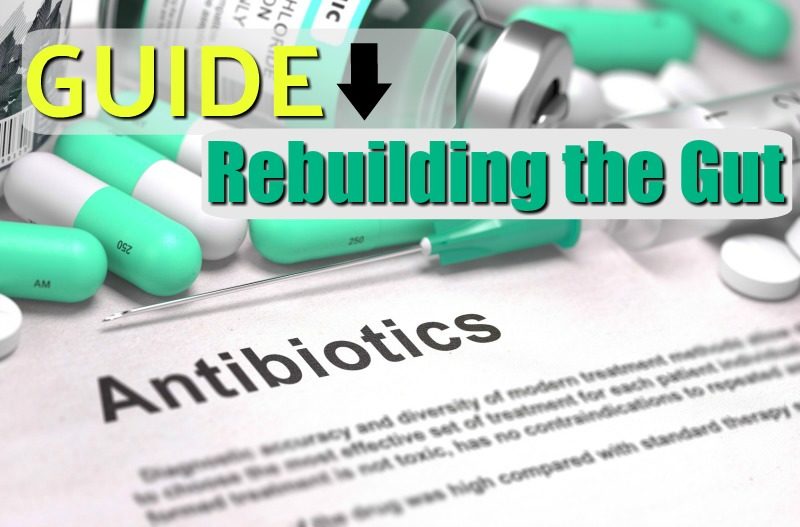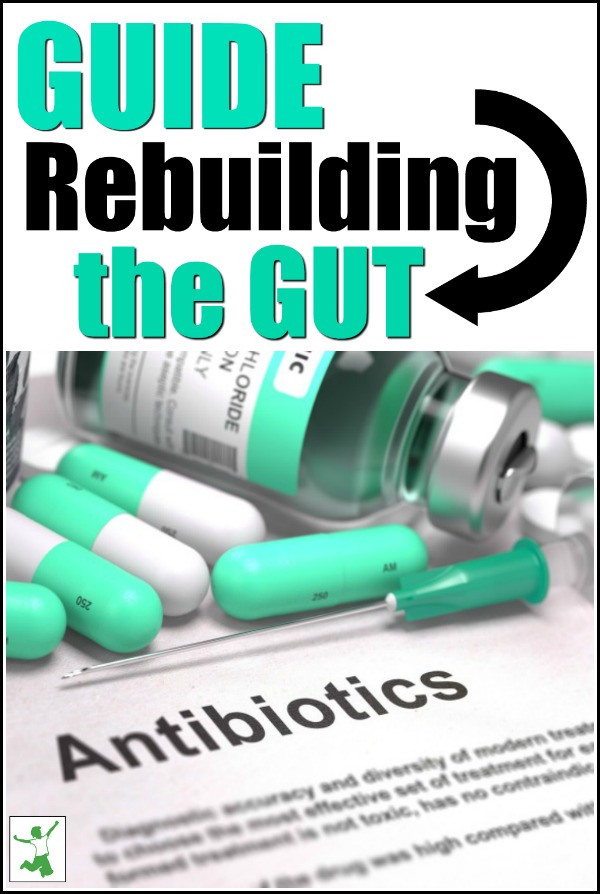
Antibiotics are truly a wonder of modern medicine. Never in a million years did the scientists that developed them think that nearly 100 years later, people would desperately need to take action to repair the gut after antibiotics are taken.
Beginning with the discovery of penicillin by Alexander Fleming in 1928, the pure magic of antibiotics with their rapid resolution of bacterial infections of all kinds caused many in the medical profession to become completely enamored with the drug-based approach to illness. By 1940, antibiotics had come into widespread use causing both doctors and people to gradually forget about tried and true techniques for preventing illness such as the age-old remedy cod liver oil.
This change in the medical paradigm has led in recent decades to abuse of these magical meds and the growing threat of antibiotic-resistant bacterial strains. It has also caused an epidemic of people with compromised gut function due to an imbalanced intestinal environment resulting from excessive exposure to antibiotics via industrially produced foods, medicine, and more recently, groundwater contamination.
While antibiotics clearly have their place in treating life-threatening bacterial infections, their overuse has led to a plethora of modern-day health challenges and autoimmune diseases.
While complete avoidance of all antibiotic exposure would be ideal, it is simply not practical in the majority of cases. Sometimes, antibiotics are necessary and when such a situation arises, it is imperative to protect the gastrointestinal tract from fungal or yeast overgrowth during treatment and to replenish beneficial gut bacteria when the course of antibiotics is complete.
While antibiotics effectively kill both pathogenic and beneficial bacterial strains with the exception of antibiotic-resistant species of streptococcus and other strains, they do not affect the many forms of yeast such as Candida albicans naturally found in the body in a non-dominant role. They also have no effect on the newly emerging super fungus Candida auris.
As beneficial bacteria lining the gut wall are eliminated, yeasts like Candida albicans have the opportunity to overgrow and become dominant by attaching to the gut wall. Once attached to the gut wall, yeast has the ability to create lesions in the cell membranes. This can lead to the syndrome referred to as “leaky gut”, which increases the likelihood of foreign proteins entering the bloodstream resulting in inflammation, food intolerances, a myriad of digestive problems, autoimmune disease, and other associated imbalances.
If you or a loved one find yourself in a situation where antibiotics are critically necessary and cannot be avoided with holistic therapies, the following recommendations for support during and after antibiotic treatment can help minimize the damage to the gut environment and quickly rebuild gut flora at the conclusion of treatment.
Repairing the Gut After Antibiotics
These recommendations are provided to patients of the clinic Biodynamic Wellness which specializes in helping people recover and maintain the optimal balance of the intestinal environment to encourage vibrant health free of chronic disease stemming from a compromised gut. The owner of Biodynamic Wellness, Kim Schuette CN, generously gave permission to share the recommendations listed below.
Please note that these recommendations are helpful whether the antibiotic treatment came from oral medication or IV treatment.
Contrary to popular belief, IV antibiotics also heavily damage gut flora despite the fact that the medication does not make its way directly through the intestinal environment like oral meds do.
Note that colonoscopies devastate gut flora in the same way. Hence, the protocol below is helpful to utilize if you must endure one for whatever reason.

Diet During and After Antibiotics
- Include generous servings of Lacto-fermented dairy and cultured vegetables during and after antibiotics whether oral or from an IV treatment. One tablespoon to half a cup of yogurt, kefir, kimchi, sauerkraut, beet kvass, etc. two to three times daily is advisable.
- Include gelatin-rich foods such as homemade meat stocks and bone broths daily along with abundant vegetables, animal fats, coconut oil, and skate or cod liver oil after antibiotics are completed. Powdered gelatin can be used to further boost homemade soups and sauces.
- Avoid all refined carbohydrates and fruit juices.
Support During Antibiotics
- Saccharomyces boulardii: one capsule twice daily to discourage yeast overgrowth during antibiotic treatment when beneficial gut flora is being compromised.
This particular strain is very important to maintaining gut wall integrity throughout a round of meds and keep Candida in check.
Gut Replenishing Supplements
Note the following probiotic supplements to take and how long to take each to give the gut its best chance to repair quickly.
- After antibiotics (or a colonoscopy), make sure to take a high quality probiotic. Suggested brands are listed on my Shopping Guide which I often re-vett for ingredient changes. Take twice daily for 60 days ideally after meals.
- Saccharomyces boulardii: one capsule twice daily to discourage yeast overgrowth during the gut flora recovery phase. Be sure to continue for 30 days.
- Note that not all beneficial bacteria are created equal for repairing the gut. Be sure to match specific probiotic strains to the function you wish it to perform and the ailments you are working to resolve.
This short video summarizes the protocol.
More Information
Are Antibiotics Always Necessary for Strep Throat?
The 11 Best Natural Antibiotics and How to Use Them
Why Antibiotics Today Could Threaten Your Life Tomorrow
How to Kick Strep Throat Faster and Better Without Antibiotics








Hey I’m looking for some advice, 2 months ago I was on a regimen of antibiotics for about an entire month. I felt fine while I was on them and recovered from having really bad strep throat. Then two weeks after I discontinued the antibiotics I started to have nausea, dull flank ache, and my stool is still not normal looking. The only thing that resolves my nausea is when I eat whole grains and cooked meats. From your experience can you tell me if these could be side effects from the antibiotics? Thanks for the great content I look forward to reading more.
Would this protocol be the same for an infant or toddler?
I would suggest reaching out to a functional doctor about this question.
My son is 3.5 years old. He has ASD and leaky gut. He got his first ear infection. We tried the natural way with garlic/Mullen drops but he had fever for 2 days and complaining of ear pain. His pediatrician recommended antibiotics. He first was given amoxicillin for 10 days but another mother advised me to try the Z-pack for 5 days. I’m reading your article and noticed you recommended Saccharomyces boulardii. We have given him Ther-biotic complete 1 time per day. Should we add in the Saccharomyces boulardii also? Or should we only give Saccharomyces boulardii during antibiotic course and add in probiotics after? Also, you recommend 2x/day. Is that for children and adults? Thank you so much.
Sir i am suffering from constipation and gas since two year after treatment of infection that create bowel in my body. A greatest thing is that my stool is not dry or hard.sir please help me docters told me that it is ibs and they treated by i do not feel any relax.
Hi, do you think that taking antibiotics while breastfeeding can have a very negative effect on my baby?
Yes I do. I would avoid it if at all possible. Have you tried any natural antibiotics? They work wonders! Unless it is a life threatening situation, they are a fantastic option. I personally use garlic for infections and it works amazingly well. https://www.thehealthyhomeeconomist.com/how-to-use-best-natural-antibiotics/
Thoughts on occasional glass of wine with dinner? Sadly I’m starting a low strength 30 day dose (haven’t taken in years) due to an internal infection. I will be following this list closely!
Hello
There are many “broad” probiotics out there which claim to be all you need to take; such as Progressive Labs “Broad Spectrum Probiotic” Is there another broad probiotic (wide range) that you would highly suggest?
I thank you for your wonderful website. I follow you on Facebook, and find it to be a wonderful resource for me to share with my clients.
Thank you
Gina
Hi! Thank you for the very helpful recommendations, they were very handy to us a year ago with a kid with pneumonia. I came back to this post now, since our 7 month old had to take antibiotics due to a ruptured eardrum. We had just started introducing egg yolk as her first food when this happened. I only tried once more while she was still sick, but she vomitted big time(projectile) and I haven’t tried since then. Since it’ s proven that even a single round of antibiotics can cause a leaky gut, I’m wondering whether the baby might became intolerant to the newly introduced foods. And since we have a history of autoimmune diseases in our family, I’m pretty worried. So for the time being I’m only breastfeeding her, till I figure out what the best thing to do would be. What would you recommend? Thank you very much
Hi. Is the Saccharomyces Boulardii ok to give children? My two year old was hospitalized with a bad case of pneumonia. He’s doing much better and I’m doing probiotics and lots of bone broth and home made gellatin snacks but I wondered if the Saccharomyces Boulardii would good for him also. Thank you!
Yes. Florastor for kids is a sacchromyces boulardii probiotic.
Wondered about the best way to do this, thank you for the specific suggestions.